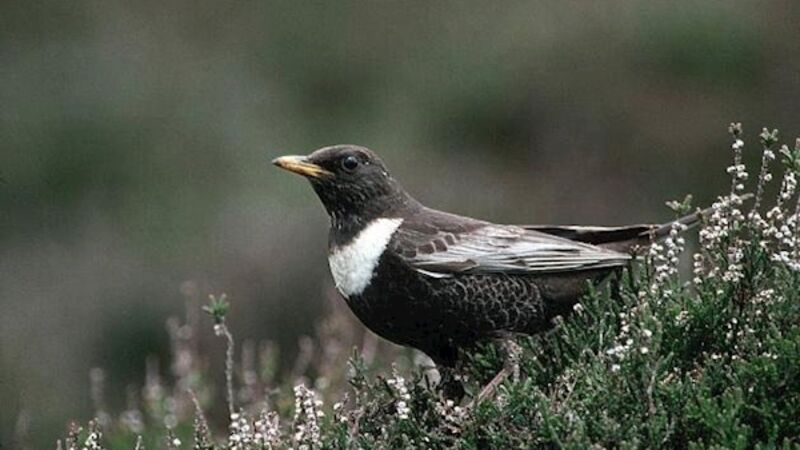Marginal ring ouzel could be next to disappear

WE WORRY that curlews and corncrakes are disappearing, but other species are going to the wall unlamented. A hundred years ago, for example, the corn bunting bred throughout the country. Then decline set in. By 1950, this plump little seed-eater was confined to headlands and islands. During the 1970s, its evocative song, “the jangling of a bunch of keys”, could still be heard on the Mullet Peninsula and a few other places. A decade later, the bird was gone.
The days of another marginal species now seem to be numbered. “The ring ouzel,” declares Alan Mee in the current edition of Irish Birds, “is one of the most poorly studied and threatened species in Ireland.”
Will it, like the corn bunting, vanish unnoticed from our shores? Is there anything we can we do to save it?
“The ouzel cock so black of hew with orange tawny bill,” rhymes Bottom in A Midsummer Nights Dream. ‘Ouzel’ was the traditional name of the blackbird, but now only its upland-dwelling cousin bears the name. This member of the thrush family is slightly smaller than the blackbird and its plumage is a duller, scruffier shade of black. A white crescent-shaped ring is worn, like the Bronze Age torcs of old, around the neck. The female, unlike her garden-dwelling relative, is not brown, but a mottled dark grey. Her ‘ring’ is less conspicuous than her mate’s.
Ring ouzels breed in mountain gullies and ‘boulder scree’ slopes, at least 250m above sea level. A century ago, some nested down to sea level. These migrants to our shores spend the winter around the Mediterranean.
Morocco’s Atlas Mountains seem to be a favourite haunt of those that come here. Shy creatures, they avoid people; in Orkney folk tradition, the ouzel is a banshee surrogate. One seen near a dwelling is a harbinger of death.
Although difficult to observe, the bird’s presence is easily detected, at least in spring; the call and jerky song are evocative. I used to hear it on visits to Glenmalure and around the corrie lakes of the Comeraghs. Alas, the loud ‘tuck’ anxiety note is no longer heard at these locations. A vital presence is gone from the mountains.
Ouzels still breed in Kerry and Donegal, but in pitifully small numbers. Alan Mee found just 11 ‘apparently occupied’ sites in the MacGillycuddy’s Reeks during a survey he conducted in 2008. By 2011, there were only four. But what is turning this bird against coming to Ireland?
A decade ago, Innes Sim and colleagues studied ouzels in the Moorfoot Hills in Scotland. They compared breeding success during the period 1998 to 2000 with that between 1952 and 1985. “Breeding sites,” they found, “were more likely to have remained occupied if they were at higher altitudes and had more heather cover” locally.
“Lack of heather may prevent otherwise suitable breeding sites from becoming occupied by ring ouzels.” So, is climate change implicated in the decline?
“A mosaic of heather patches, as cover and open areas to forage, appears to be important’ for the species,” says Mee. He feels that “habitat management, to restore or maintain heather-grass mosaics at key sites, should be an important and urgent conservation measure for ring ouzels in Ireland”.
Allan Mee. The status and ecology of a remnant population of ring ouzel in the MacGillycuddy’s Reeks, Kerry. Irish Birds. 2019.












